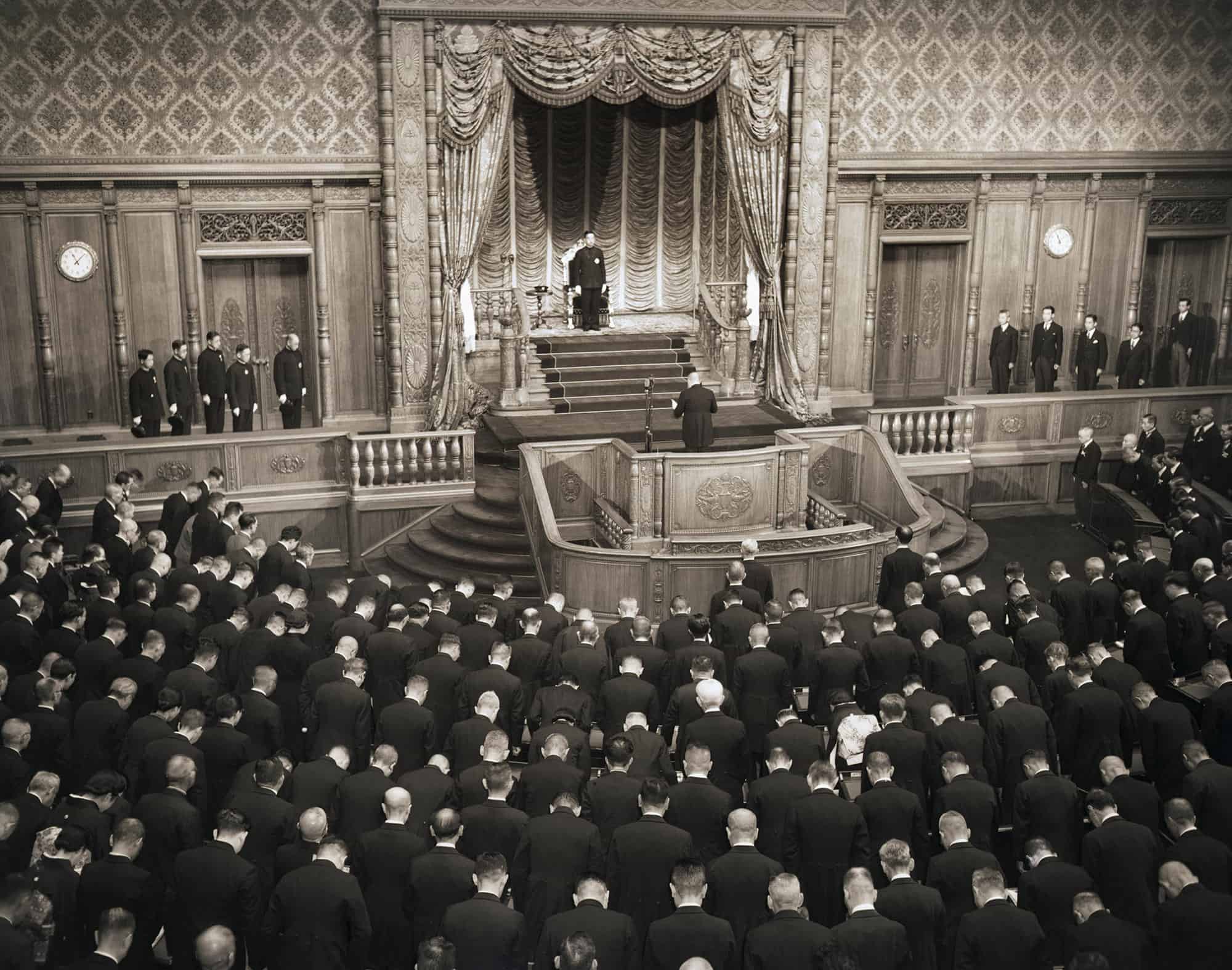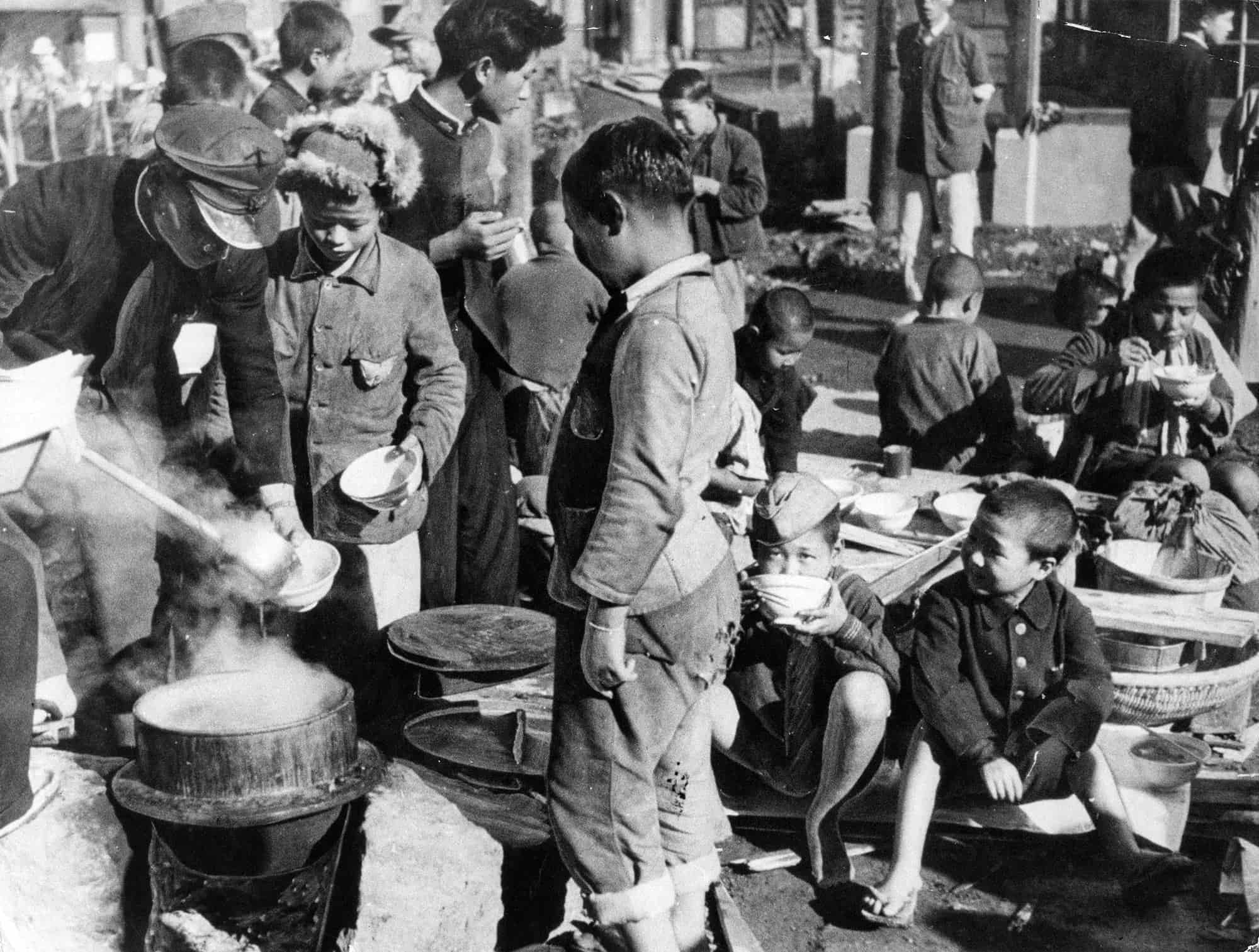Japan’s Postwar Constitution
The 1947 constitution altered the relationship between state and society by introducing popular sovereignty. The constitution’s social reforms were transformative, designing a new role for the Japanese imperial family, placing the nation’s military firmly under civilian control, and establishing new rights for women. Those who have argued most strenuously for revision of the document chafe against its occupation origins. More recently, the Japanese people have been more open to thinking about how the constitution could be amended to reflect challenges Japan faces in the twenty-first century.
Origins Under Occupation
World War II left Japanese cities physically devastated and over two and a half million Japanese people dead. Those who lived through the war faced immense hardship.
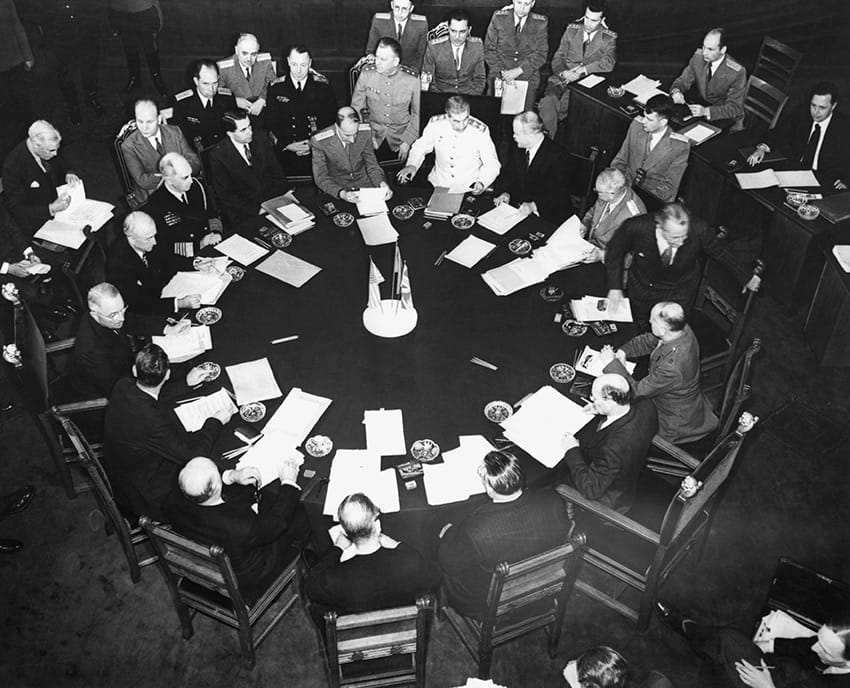
Demilitarization and Democratization
In Potsdam, Germany, on July 26, 1945, the leaders of the United States, China, and the United Kingdom set forth the terms for Japan’s surrender. On September 2, Japan surrendered unconditionally to the Allied powers, and in doing so accepted the premise of democratic reforms.

Allied Occupation of Japan Begins
The Allied powers shared responsibility for post-surrender Japan, but it was U.S. General Douglas MacArthur who shaped the rewriting of Japan’s constitution. On September 2 the Allied occupation of Japan began, after surrender documents were signed on the USS Missouri in Tokyo Bay. MacArthur became supreme commander of the Allied powers and established headquarters in the Daiichi Insurance building, just across from the Imperial Palace.
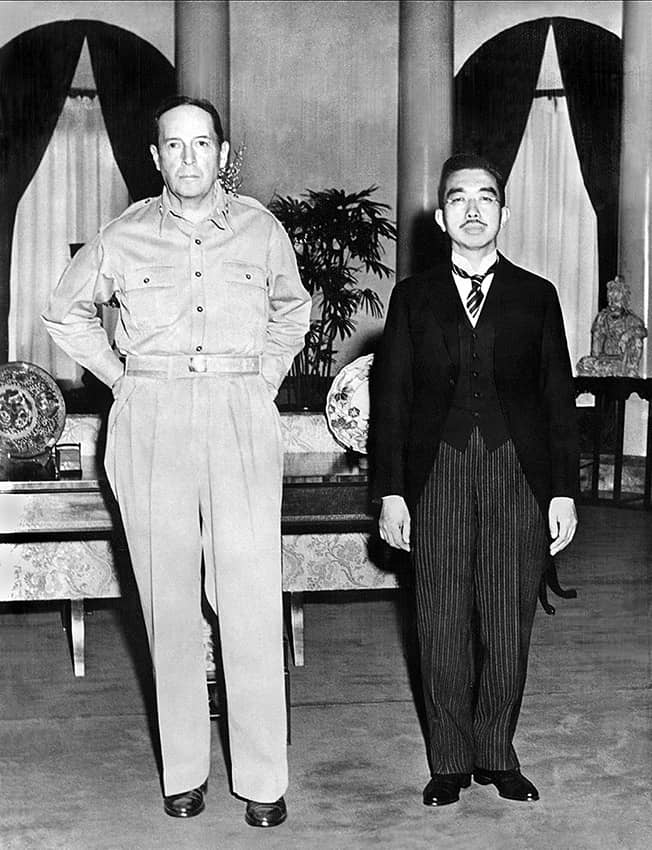
The Allied Occupation and the Japanese Emperor
Post-surrender planning for Japan focused on the future role of Japan’s emperor. Some allies saw Emperor Hirohito as responsible for Japan’s military expansion across Asia and the Pacific. U.S. diplomat and Japan expert Hugh Borton, who helped draft planning documents for the Allied occupation of Japan, argued that retaining the emperor was the best means of gaining the cooperation of the Japanese people in the reform of their country.

Competing Interests
After the war, Japanese authorities sought simply to amend the 1889 Meiji Constitution. But the Allies wanted a far more ambitious change. In Washington, the U.S. State Department was finalizing its occupation plans, as outlined in the State-War-Navy Coordinating Committee’s document SWNCC 228. In Tokyo, Supreme Commander of the Allied Powers Douglas MacArthur was setting up his headquarters. Meanwhile, the Far Eastern Commission—comprising thirteen countries, with veto powers given to the United States, China, the Soviet Union, and the United Kingdom—was established to oversee Japan’s occupation. MacArthur and his staff felt the need to move quickly, as the members of the Far Eastern Commission were beginning to assert their interests in shaping postwar Japan.

MacArthur’s Three Principles
General MacArthur created three principles to guide the drafting of the new constitution and set the Supreme Commander of the Allied Powers staff (SCAP) to work. MacArthur wanted to make the emperor accountable to the Japanese people, eliminate Japan’s ability to wage war, and create a parliamentary system akin to the British system, abolishing the inherited power of Japan’s aristocracy.

SCAP Introduces Sweeping Reforms
The Supreme Commander of the Allied Powers’ Government Section, headed by General Courtney Whitney, was tasked with drafting the new constitution in one week. Colonel Charles Kades oversaw the drafting process, and his staff, many of whom were influenced by the New Deal, tackled the issues of women’s rights, land reform, and the breakup of the zaibatsu, Japan’s industrial and financial conglomerates. They also sought to establish democratic freedoms: those of assembly, speech, and religion.
Disagreement Between SCAP and the Japanese Cabinet
On February 8, 1946, Joji Matsumoto, chairman of the Constitutional Problems Investigative Committee in Prime Minister Kijuro Shidehara’s cabinet, presented SCAP with the Japanese government’s proposed constitution. General Whitney rejected it, as it barely amended the Meiji Constitution. On February 13, Whitney presented SCAP’s draft constitution in its place. The Shidehara cabinet accepted the draft a week later. Charles Kades and Tatsuo Sato, from the cabinet’s Bureau of Legislation, then negotiated a new draft based on the SCAP document, and the cabinet released it to the public on March 6.
A Hard Recovery
In the year after the war ended, economic conditions worsened in Japan. Food shortages were severe, many people had no home, and few had jobs.
The First Postwar General Election
Competitive elections had tapered off in the 1930s, as the military consolidated its political power. The general election of April 1, 1946, brought many former politicians and other leaders back into politics. It also brought Japanese women to the ballot box for the first time. The Liberal Party, led by prewar diplomat Shigeru Yoshida, won a plurality of seats in the lower house. Yoshida then formed a coalition government with the Japan Progressive Party, which included many politicians associated with the statist Imperial Rule Association prior to the war. The Yoshida cabinet turned its attention to the constitution.

Pressure From the Far Eastern Commission
The Soviet Union wanted a larger voice over the reforms imposed on Japan through the Far Eastern Commission. To limit its influence, MacArthur urged the Yoshida cabinet to hasten its approval of the new constitution.
Legislative Edits to Government Draft
On June 20, 1946, the Yoshida cabinet submitted the Bill for Revision of the Imperial Constitution to the Diet for its review. Hitoshi Ashida of the Liberal Party chaired the review committee in which ruling and opposition party legislators put forward their ideas, incorporating expert opinions from civil society advocates. Two ideas were incorporated into the draft: a commitment to ensuring an adequate standard of living for the Japanese people (Article 25) and an extension of free compulsory education through middle school (Article 26).
Debate on Article 9
A sustained debate on Article 9 unfolded. SCAP had included language from the Kellogg-Briand Pact of 1928 to ensure that Japan would "abandon force as a means of settling international disputes." Some legislators wanted to embrace this idea assertively to reflect Japan’s commitment to peace and maintaining a stable world order. Others were less enthusiastic about limiting Japan’s hand. In the end, Ashida presented a compromise, amending the article’s second paragraph to read that Japan would not maintain armed forces for the purposes of aggression, thereby carving out Japan’s right to self-defense, as stipulated in the UN Charter.

Diet Approves Revised Draft
Ashida put the new draft forward for a vote on the floor of the Diet. It was approved on October 7 with only five votes opposing.
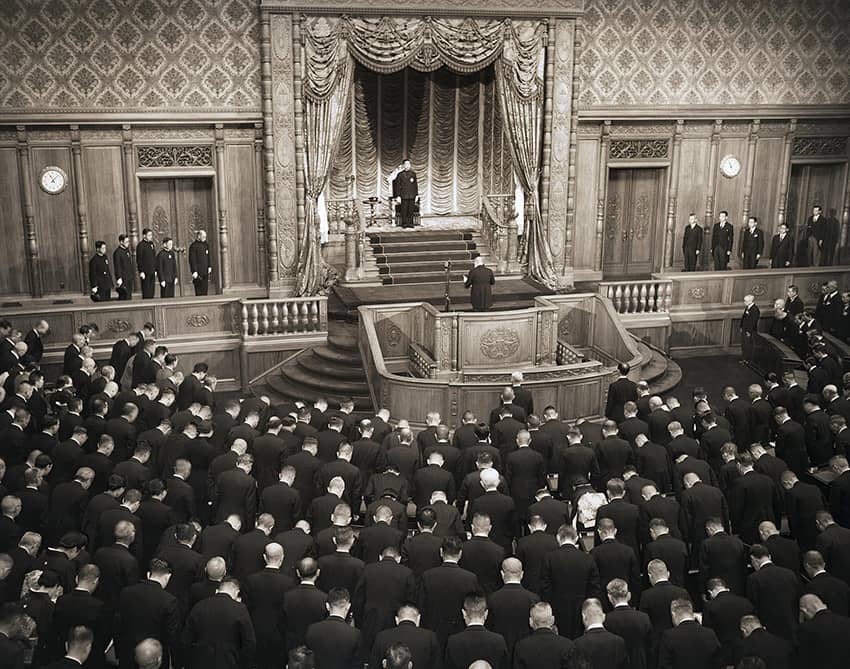
The Emperor Announces the Constitution
The Meiji Constitution had stipulated that only the emperor had the authority to revise Japan’s constitution. On November 3, 1946, Emperor Hirohito announced the new constitution, so that the Japanese people would see it as legitimate.



Explaining Citizen Rights to the Public
After the new constitution was promulgated, government officials presented it to the Japanese people, traveling across the country to disseminate publications explaining what the document meant for Japanese citizens.
The Effect of the 1947 Constitution on Society
The postwar constitution changed the way the Japanese were governed and also spurred social change. Some of the biggest changes include the role of the emperor, the role of the military and use of military power, and women’s rights.
The Emperor and the Japanese People
The 1947 constitution changed the emperor’s role from head of state to the “symbol of the state and of the unity of the Japanese people.” Three emperors have reigned since this constitution was promulgated: Emperor Hirohito (Showa era), Emperor Akihito (Heisei era), and Emperor Naruhito (Reiwa era).
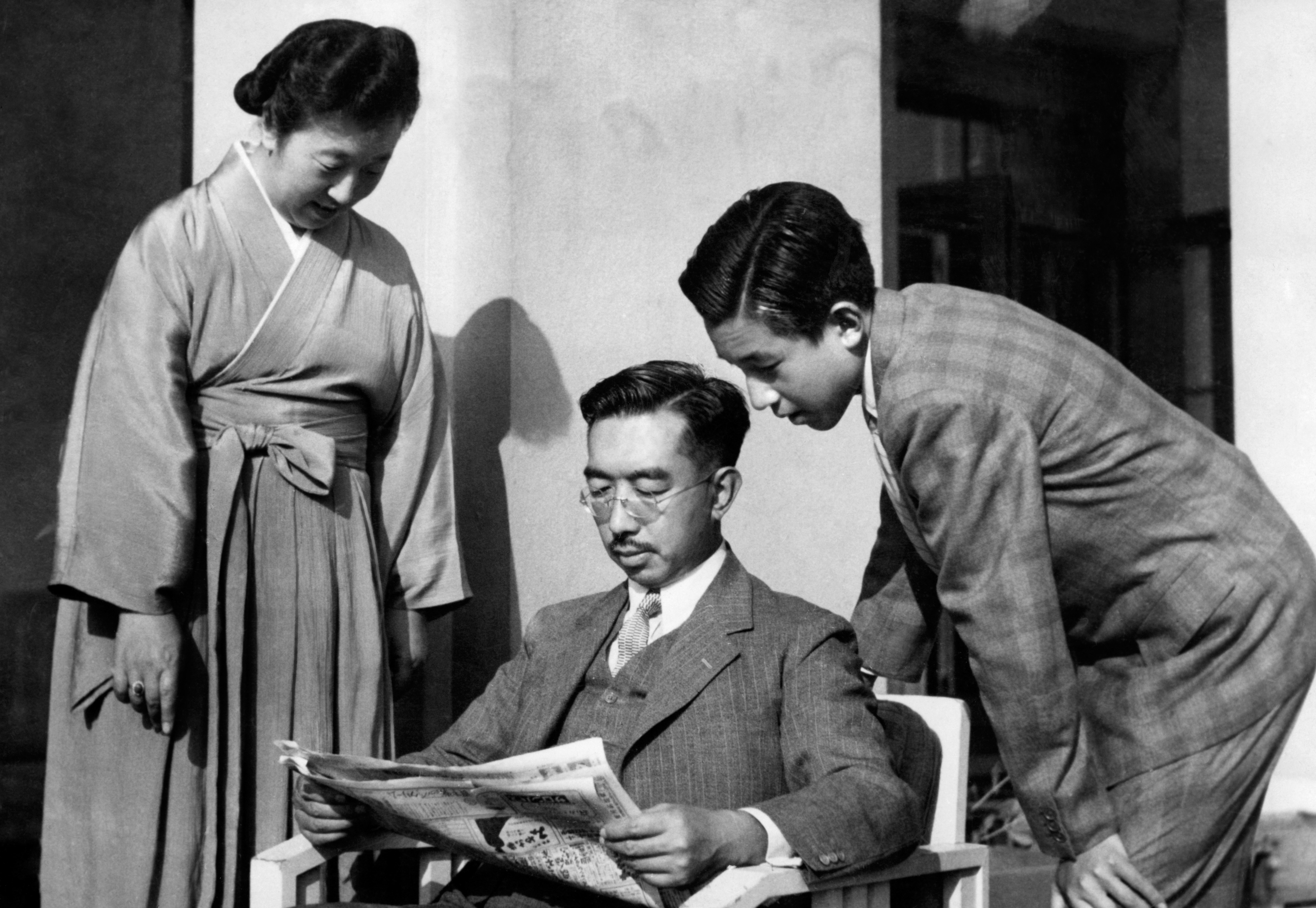
The Showa Emperor Transitions
Hirohito remained emperor long into the postwar period, and his reign, the Showa era, bridged Japan’s momentous prewar and postwar transformations. His official duties became largely ceremonial. The emperor receives the credentials of foreign ambassadors sent to Japan, sends Japanese ambassadors abroad with his blessing, and opens each session of the Diet.

The Heisei Emperor
With Hirohito’s death in 1989, his son Akihito became Japan’s new emperor and the Heisei era began. Emperor Akihito has no association with Japan’s imperial past or the war that ended those ambitions. An active and visible symbol of the state, he has made efforts to heal the longstanding wounds of the war, traveling with Empress Michiko to Indonesia, Malaysia, and Thailand in 1991, as well as visiting China in 1992.

Unity in Crisis
In the months after the March 11, 2011, Great East Japan Earthquake, Emperor Akihito and Empress Michiko visited evacuation centers in Tokyo as well as disaster-hit areas in Tohoku to provide encouragement to evacuees, listening to their stories and indicating that the nation would support them.

Emperor Akihito Abdicates
The capacity of the imperial family to adapt was yet again demonstrated when eighty-three- year-old Akihito announced his desire to step down and allow his son to take over his duties. Supported by the Japanese people, the Diet passed a law in 2018 to allow the first abdication of a Japanese emperor in the modern era. Emperor Naruhito took the throne the following year, and the Reiwa era began.
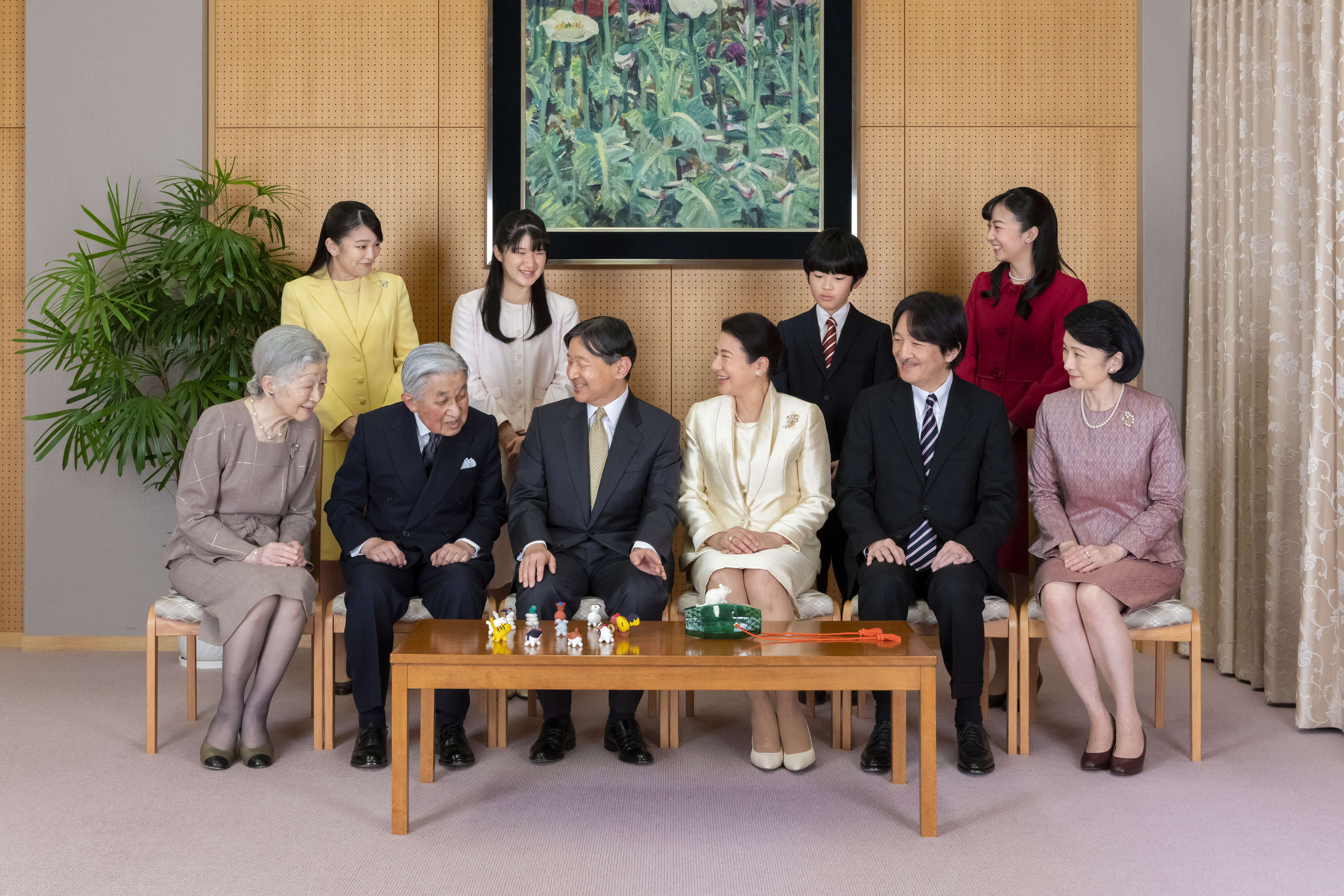
The Challenge of Succession
The role of the imperial family under the constitution remains important to the Japanese people. The issue of succession remains unresolved, however.
The Self-Defense Forces
The 1947 constitution’s most celebrated innovation was Article 9. By the time the constitution came into effect, Japan’s imperial military had been dismantled and its leaders tried for war crimes. A new military was created in 1954, named the Self-Defense Forces (SDF), with the mission of defending Japan. Today, Japan’s SDF works with partners around the globe.

Putting Civilians in Charge
The new constitution banned members of the military from the highest positions of government (Article 66). Japan’s military was placed under the direct authority of democratically elected officials. A new agency, the Defense Agency, was created under the prime minister’s office to manage defense planning.

Interpreting Article 9
Interpreting Article 9 created hurdles for Japan’s postwar leaders. Diet debates over defense policy were contentious, with legislators often disagreeing on how to interpret Article 9. The constitution implied limits on using force, a challenge that to this day shapes decision-making on when and how the SDF can use its weapons.

The U.S. Military in Japan
Prompted by the Korean War, Japan and the United States signed a security treaty in 1951 that allowed U.S. military forces to remain after the San Francisco Peace Treaty was concluded.
Throughout the 1950s, Japanese citizens grew increasingly unhappy with the continued U.S. military presence. In 1957, the killing of an elderly Japanese woman by a U.S. Army guard drew national outrage and demands to end the extraterritoriality that protected U.S. military personnel from Japanese prosecution.
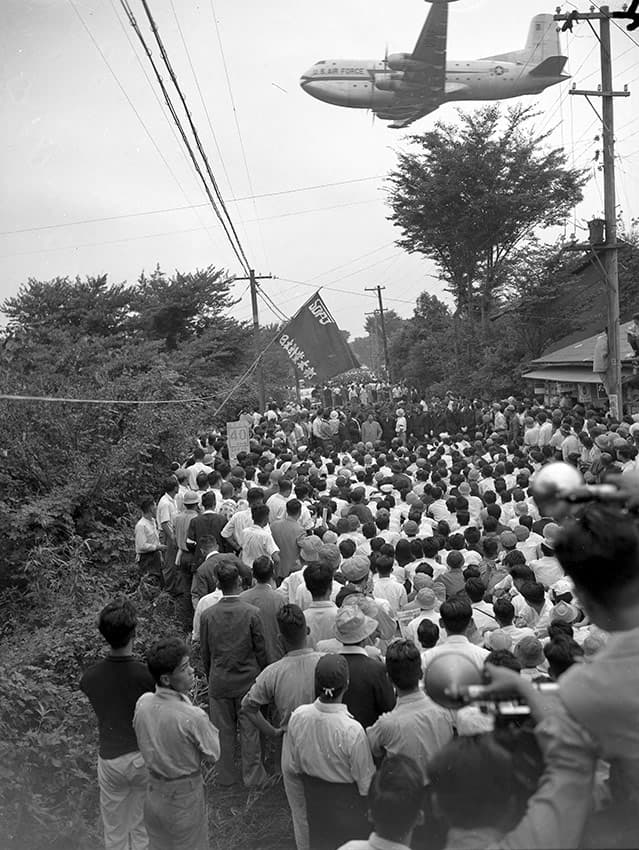
Constitutional Challenge
In 1955, another controversy arose when U.S. forces asked the Japanese government to extend the runway at Tachikawa Airfield. Tokyo began land expropriation procedures for adjacent land in Sunagawa, but this drew intense citizen protest. Ultimately, the Japanese courts ruled that using private land for military purposes violated Article 9. Years later, declassified U.S. documents revealed that Japanese Supreme Court Justice Kotaro Tanaka had consulted with the U.S. Embassy over his decision, provoking deep resentment within Japan over the lack of judiciary independence.

Base Protests in Okinawa
The Sunagawa ruling influenced citizens’ challenge of land use for military purposes in Okinawa. On May 15, 1972, Prime Minister Eisaku Sato and President Richard M. Nixon agreed to revert Okinawa to Japan. U.S. bases remained, however, and Okinawan landowners maintained that the continued use of their land by U.S. forces ran counter to the Supreme Court’s Sunagawa decision. Today, anti-base protesters in Okinawa continue to accuse Tokyo of discrimination, claiming that their rights are still not fully protected.

Japan’s Evolving Military
Japan had rebuilt its military by the early 1970s, and civilian planners in the Defense Agency announced the first National Defense Program Outline in 1976. Defense Agency Director General Michita Sakata declared the SDF to be a “small but significant force” and opened a dialogue with Washington on how to ensure the defense of Japan. The 1978 Guidelines for Japan-U.S. Defense Cooperation became the first statement of how U.S. and Japanese forces would work together.
After the Cold War ended, Japan began sending the SDF to contribute to global coalitions, including UN peacekeeping. The SDF’s first such mission was to Cambodia in 1992. As of 2020, Japan has participated in nine UN peacekeeping missions. The SDF also joined the U.S.-led coalition in Iraq and the anti-piracy mission in the Gulf of Aden.

Japan’s Right of Collective Self-Defense
As the military power of Japan’s neighbors, China and North Korea, grew, the SDF increased its cooperation with other militaries. Tension between the government’s interpretation of Article 9 and the operational demands of the SDF’s new missions became increasingly clear.
In 2014 the Abe cabinet reinterpreted the constitution as allowing for "collective self-defense," described as the use of force on others’ behalf if Japan’s security was threatened. The following year, the government presented legislation to the Diet that specified how this reinterpretation would be implemented, which drew both citizen protest and parliamentary opposition. The legislation passed the upper house by a vote of 148 to 90 on September 19.
Women in Japanese Society
Women gained the right to vote in 1945. Article 24 in Japan’s 1947 constitution then gave women economic independence and the right to make their own choices.

Beate Sirota Gordon, Architect for Women’s Rights
Beate Sirota Gordon, a U.S. citizen who grew up in Japan, was a member of the Government Section of SCAP. She was tasked with drafting women’s rights into the constitution.
The constitution had a profound effect on the lives of women, but gender equality remains incomplete. In 2014, the Abe cabinet introduced a new initiative, dubbed womenomics, to encourage more women to participate in the Japanese economy and prompt Japanese companies to address gender inequality by hiring and promoting more women.
But other social norms continue to shape the lives of Japanese women. Not until 2007 did Japanese women legally gain access to their husbands’ pensions when they divorced, and still today Japanese women cannot use their own last names after marriage.
In 2020, the Organization for Economic Cooperation and Development (OECD) ranked Japan as having the seventh-highest gender gap in labor-force participation among OECD countries (based on 2018 data). As of October 2020, women’s labor force participation rate was 73.4 percent, trailing men’s by 15.9 percentage points.
